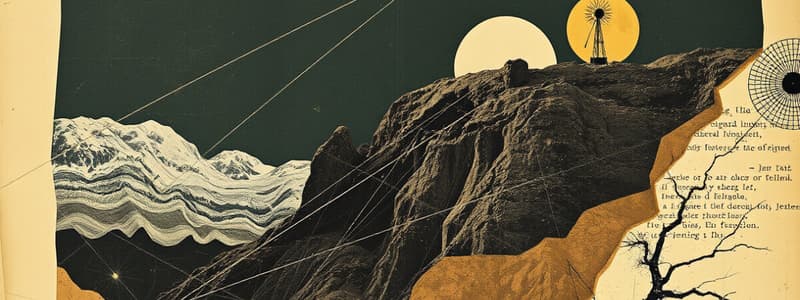Podcast
Questions and Answers
Which feature is created by deposition from rivers?
Which feature is created by deposition from rivers?
- Deltas
- Gullies
- Alluvial fans (correct)
- Oxbow lakes
Which formation is one feature of karst topography?
Which formation is one feature of karst topography?
- Caves (correct)
- Plateaus
- Hills
- Mountains
How do erosion and deposition work together to create a moraine?
How do erosion and deposition work together to create a moraine?
Glaciers cause erosion as they melt, carrying sediment that gets deposited in a thick layer.
How do erosion and deposition work together to form sand dunes?
How do erosion and deposition work together to form sand dunes?
Which materials are moved by runoff?
Which materials are moved by runoff?
Which action can humans take to reduce wave erosion?
Which action can humans take to reduce wave erosion?
Which features help reduce the amount of runoff that occurs in an area?
Which features help reduce the amount of runoff that occurs in an area?
Which feature may form as a result of erosion related to runoff?
Which feature may form as a result of erosion related to runoff?
How do waterfalls form?
How do waterfalls form?
Which factor affects the amount of runoff that occurs in an area?
Which factor affects the amount of runoff that occurs in an area?
How are deltas formed?
How are deltas formed?
Which word describes the water stored below Earth's surface?
Which word describes the water stored below Earth's surface?
Which is the top layer of groundwater?
Which is the top layer of groundwater?
Which word identifies the hanging icicle-shaped formations in caves that are created by deposition?
Which word identifies the hanging icicle-shaped formations in caves that are created by deposition?
Which processes form glaciers?
Which processes form glaciers?
Which is one place that glaciers are found?
Which is one place that glaciers are found?
Which type of erosion can place a boulder in the middle of a field?
Which type of erosion can place a boulder in the middle of a field?
Which is one way that waves erode coastlines?
Which is one way that waves erode coastlines?
Which feature is created by wave erosion?
Which feature is created by wave erosion?
How is loess beneficial?
How is loess beneficial?
Which process wears away tall sandstone rock formations due to wind?
Which process wears away tall sandstone rock formations due to wind?
Which method best helps to prevent wind erosion?
Which method best helps to prevent wind erosion?
Which feature is most likely impacted by gravity because it can form at the bottom of a steeply sloped river?
Which feature is most likely impacted by gravity because it can form at the bottom of a steeply sloped river?
How do oxbow lakes form?
How do oxbow lakes form?
Which action would best help prevent groundwater erosion?
Which action would best help prevent groundwater erosion?
Which type of deposition creates sandbars?
Which type of deposition creates sandbars?
Which process involves wind moving loose sediment?
Which process involves wind moving loose sediment?
Flashcards are hidden until you start studying
Study Notes
Erosion and Deposition Phenomena
- Alluvial Fans: Formed by deposition from rivers, creating fan-shaped features at the base of slopes.
- Karst Topography: Characterized by formations such as caves, formed through the erosion of soluble rocks.
- Moraines: Created when glaciers melt, carrying and depositing sediments in thick layers.
- Sand Dunes: Result from erosion through deflation, with deposited sand accumulating against obstructions.
- Nutrient Runoff: Runoff water carries important nutrients away, affecting soil fertility.
Human Impact on Erosion
- Wave Erosion Mitigation: Breakwaters can be constructed in oceans to reduce wave impact on coastlines.
- Vegetation and Runoff: Increased vegetation in an area can significantly reduce runoff, promoting soil stability.
- Gullies: Features formed as a result of erosion due to water runoff, indicating severe soil erosion.
- Waterfall Formation: Occur when soft rock erodes, leading to the creation of waterfalls over harder rock layers.
- Land Use Influence: The type of land use directly affects the rate of water runoff, with urbanization often increasing runoff.
Water and Groundwater Features
- Deltas: Formed through deposition where rivers meet lakes or oceans, creating rich sedimentary environments.
- Groundwater: Stored beneath the Earth's surface, with the water table representing the top layer of this underground water.
- Stalactites: Icicle-shaped formations created by deposition in caves as minerals precipitate from dripping water.
- Oxbow Lakes: Form when rivers erode banks until a segment is cut off, creating a distinctive lake shape.
Glaciers and Erosion Processes
- Glacier Formation: Results from processes of accumulation and compaction over time, leading to the creation of glaciers in cold regions.
- Plucking: Type of erosion where large boulders are lifted and deposited by moving glaciers.
- Coastal Erosion: Waves cause erosion through a back-and-forth movement that loosens and removes sediment and rock.
- Stack Formation: Features created by the erosion of rock due to wave action, leading to unique coastal structures.
Soil and Wind Erosion
- Loess: Fine soil deposits beneficial for agriculture, contributing to fertile land for crop growth.
- Wind Erosion: Caused by processes like abrasion, which wears away rock formations, especially tall sandstone structures.
- Agricultural Practices: Rotating crops is a key method to prevent wind erosion and maintain soil health.
- Deflation: The process involves wind removing loose sediment, contributing to the formation of features like sand dunes.
Managing Erosion
- Groundwater Erosion Prevention: Building effective drainage systems can help manage and reduce groundwater erosion.
- Sandbars: Formed through wave deposition, creating natural barriers along coastlines.
Each of these points captures the essential knowledge about the various forms of erosion and deposition and their implications on the environment and human activity.
Studying That Suits You
Use AI to generate personalized quizzes and flashcards to suit your learning preferences.




